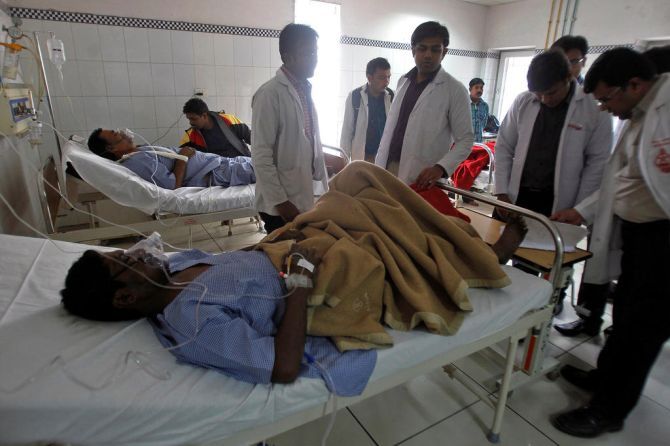While Prime Minister Narendra Modi’s Ayushman Bharat healthcare scheme remains a slogan for the moment, it is the state’s Mukhyamantri Amrutum health assurance scheme which is a comforting reality for many.
In the first of a four-part series, Vinay Umarji assesses the readiness of Ayushman Bharat in Gujarat, ahead of the September 25 launch.

Despite a mere Rs 36,000 annual family income, Vechatji Thakor, 48, is undergoing treatment for an enlarged prostate and bladder stones at PSM Hospital in Kalol, Gandhinagar, Gujarat, without lying awake at night staring at the ceiling and fretting about the bill.
While Prime Minister Narendra Modi’s Ayushman Bharat healthcare scheme is just a slogan for the farm labourer for the moment, it is the state’s Mukhyamantri Amrutum (MA) health assurance scheme which is a comforting reality for him.
Despite being a large family of 12, the Thakors have not faced any finance issues so far when they have fallen ill, thanks to the robustness of MA that covers over 4.485 million families, or 220 million individuals.
“But, of course, Rs 500,000 (the cover to be provided under Ayushman Bharat) will be better than the Rs 300,000 under MA,” said Thakor.
The MA scheme began in 2012 when Modi was chief minister.
Intended for tertiary services for below-poverty-line (BPL) families, it gradually evolved to cover families above the poverty line who have an annual income below Rs 300,000 under the extended MA Vatsalya scheme.
Unlike Ayushman Bharat, which automatically integrates BPL beneficiaries outlined by the Socio Economic and Caste Census (SECC), MA and MA Vatsalya require local health workers to reach out and register beneficiaries.
Gujarat government sources estimate, if the Rashtriya Swasthya Bima Yojana that covers the primary and secondary services is included, that 95 per cent of BPL families eligible for MA in the state are covered.
Despite this progress, neither beneficiaries nor the local machinery are aware of the Ayushman Bharat scheme in any of its details, save for Modi’s August 15 speech when he formally unveiled the national health protection scheme that intends to cover 100 million vulnerable families by providing health cover of up to Rs 500,000 per year.
Rather, it is business as usual for health personnel at the local community health centre in Kundal village of Kadi taluka, Mehsana.
The centre is busy, attracting around 35 patients a week as it boasts the only dialysis facility in the vicinity.
“We haven’t received any intimation yet about Ayushman Bharat,” said healthcare worker Zalak Dave as she wraps up the scheduling of all the dialysis patients for the day.
The systems under MA run quite smoothly. Dave is adept with the MA software.
Over the last six years, both the scheme and software have expanded from simply registering beneficiaries to empanelling hospitals and health centres.
The patients who arrive for treatment present their MA identity cards to Dave.
She keys in the details along with their fingerprint scan.
The software then directs Dave to the patient’s medical history, ongoing treatment, and any instructions listed by the doctor.
Kidney patient Meenaben Bavaliya has come for dialysis at the Kadi Centre.
After completing the admission process, she is given a printout of the Rs 2,300 bill. But getting the bill doesn’t fluster her.
She knows the government pays hospitals and centres directly for tertiary services.
Under Ayushman Bharat, states can choose how to manage identity cards.
Gujarat has chosen to continue relying on the MA cards already issued to the SECC beneficiaries and foresees no problems.
“The Centre will be issuing e-cards for Ayushman beneficiaries, which will be embedded in the software along with the existing database of the MA scheme.
"Hence, the software itself will flag any duplication. We don’t think there will be any hassle in managing the beneficiary data after the Ayushman launch,” said a health official in Gujarat.
While no guidelines have been issued by New Delhi on how to integrate the existing MA scheme with Ayushman Bharat, officials are confident the process will be smooth.
“There should be no problem in integration. The state governments have been given the choice of software to work with.
"In Gujarat, both our MA software and the Ayushman Bharat software will be seamlessly integrated through a common application programming interface,” said Jayanti Ravi, commissioner of health, medical services & medical education.
As to the September 25 deadline for rolling out Ayushman Bharat, Ravi said that while work on tendering for the insurance provider had been expedited, the overall publicity around the scheme across the state will only kick in closer to the launch.
Gujarat has chosen the ‘mixed model’ under which treatment up to Rs 50,000 per family will be covered by an insurance company, while the balance Rs 450,000 worth of cover will be assured by the government.
Oriental Insurance Company won the bid for this at a Rs 361 premium per family for cover up to Rs 50,000.
Some experts believe that the launch of Ayushman Bharat will be relatively smooth in Gujarat, given the success of MA, better facilities in terms of beds and hospitals, the number of private hospitals that have already been empanelled under MA, and the number of doctors at the primary healthcare centres.
“Too much reliance on insurance would have proved inflationary in Gujarat. The mixed model is more desirable than a pure insurance model,” said Rajesh Chandwani, chair, Centre for Management of Health Services at the Indian Institute of Management, Ahmedabad.
Moreover, banking on the volume of treatments availed of by beneficiaries under the MA scheme, private hospitals such as Kalol-based PSM Hospital are satisfied with the rates -- Rs 24,150 for a coronary balloon angioplasty, for example.
“Over 75 per cent of surgeries and other tertiary services at the hospital have been used by BPL beneficiaries.
"Since the guidelines on Ayushman have not yet come out, we are not sure how the same will be integrated with the existing scheme.
"If the rates are similar to what we are getting right now, we don’t think there should be any hiccups under Ayushman,” said Dr Jaydutt Mehta, lead doctor at PSM Hospital.
| Feeling the pulse |
|
Photograph: Reuters











